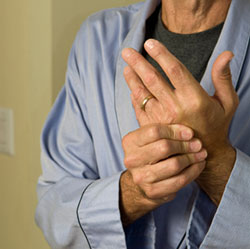
Arthritis is a form of joint disorder that involves inflammation of one or more joints. There are over 100 different types of arthritis. The most common form is osteoarthritis which is a degenerative joint disease that is a result of trauma to the joint or wear over time. Other common forms of arthritis include rheumatoid, septic and psoriatic arthritis. The most common symptom of those suffering from arthritis is joint pain. This pain is due from an inflammation that occurs around the joint. The pain is often constant and may be localized to the particular joint that is affected.
Symptoms
The common symptoms that are shared regardless of what form of arthritis the individual has includes varied levels of pain, swelling and a constant ache around the joint. Arthritic disorders like rheumatoid or lupus can also affect other organs within the body. These symptoms can include feeling tired, fever, weight loss and difficulty moving the joint. Severe arthritis can lead to limited physical activity.
Arthritis is the most common cause of disability, with many individuals having severe limitations on a daily basis. Arthritis can make it very difficult for individuals to maintain physical activity and may prevent them from doing many activities they once enjoyed.
Since many symptoms of arthritis can be associated with other diseases a medical professional will diagnose using blood tests or radiology. Pain patterns are different depending on what type of arthritis the individual has, as well as the location. Important features when it comes to diagnosing arthritis include speed and time of onset, pattern of pain, stiffness, symmetry of symptoms and other systemic symptoms. Elements of the history of the disorder guide diagnosis. Important features are speed and time of onset, pattern of joint involvement, symmetry of symptoms, early morning stiffness, and tenderness, gelling or locking with inactivity, aggravating and relieving factors, and other systemic symptoms. Physical examination may confirm the diagnosis, or may indicate systemic disease. Radiographs are often used to follow progression or help assess severity of the disorder.
Common Forms of Arthritis
Osteoarthritis
Osteoarthritis is the most common form of arthritis. It can affect large and small joints of the body, usually including the hands, feet, hip or knee. The disease can be as a result of injury or acquired through daily wear of the joint. The cartilage begins to wear and eventually causes two of the opposing bones to erode into one another. The pain can become severe and debilitating preventing the patient from doing some activities. This form of arthritis is most common in the elderly. The disease cannot be cured, but there are current therapies that can help prevent the condition from worsening. Pain medications, weight loss and physical therapy can all be very helpful.
30 percent of females have some degree of osteoarthritis by age 65. Risk factors for osteoarthritis include prior joint trauma, obesity, and a sedentary lifestyle.
Rheumatoid Arthritis
Rheumatoid Arthritis is a form of arthritis in which the body’s own immune system begins to attack the body tissues. The attack is not localized to the joint, but to other parts of the body as well. Most of the damage occurs in the joint lining and the cartilage which progresses to the erosion of two exposing bones. This form of arthritis usually affects the joints in the fingers, knees, and wrists. The disease is symmetrical and can lead to very severe deformities if left untreated. Rheumatoid arthritis occurs usually after the age of 20 and often the cause is unknown. The earlier the diagnosis, the sooner the patient can receive treatment which often leads to a better quality of life.
Treatment
Treatment for arthritis depends on what form the patient has. There are many medications that help to reduce pain and inflammation of joints which provides much needed relief for patients. Medications that help to reduce swelling and inflammation of the joints can also reduce future joint damage. In more severe cases surgery may be required in order to replace joints. Physical therapy, orthopedic bracing and medications can all help to alleviate symptoms of arthritis. Daily lifestyle changes such as diet and exercise can also allow for increased mobility in the patient. Occupational and physical therapy also have been proven to significantly improve the range of movement and relieve the stiffness of joints.
Gout
Gout is a disease caused by the crystallization of uric acid in the joints, tendons, and surrounding tissues. One of the most common symptoms of gout is inflammatory arthritis in the big toe, which accounts for approximately 50% of cases. Historically, gout was referred to as the "disease of kings", because it often caused by overconsumption of alcohol, meat, and seafood. Prevention of gout is most often achieved by following a sensible diet, and avoiding the foods which are prone to cause gout.